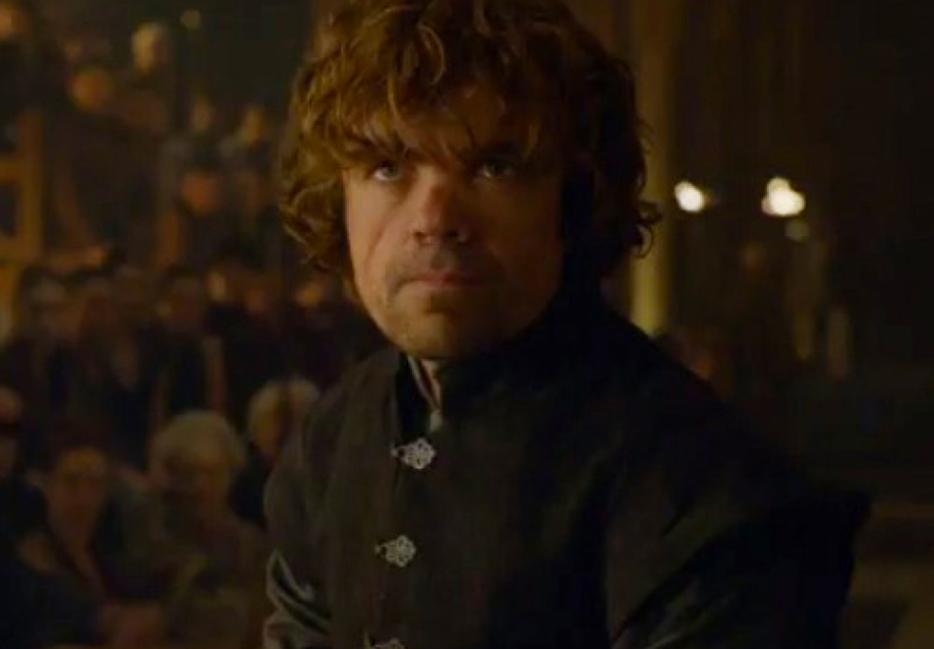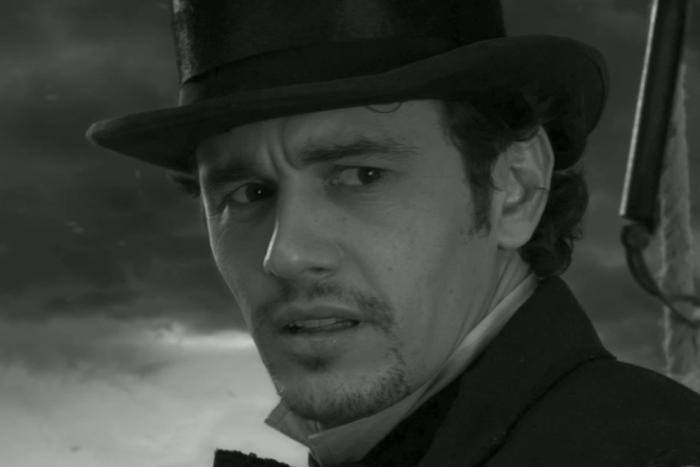Spoilers below for season four of Game of Thrones.
In a recent episode of Game of Thrones, Tyrion Lannister, played by the actor Peter Dinklage, is put on trial for the murder of his nephew, King Joffrey. He didn’t do it, but that’s beside the point. Tyrion has dwarfism, and he has long been dismissed as the “imp” of the proud, ruthless, quasi-Aryan Lannister clan; his father, Tywin, has always hated him for the shame he brought the family. As the trial comes to a climax, and Tyrion’s patience grows thin, he yells that he wants to confess. He is guilty—but not of murder. “I’m guilty of being a dwarf,” he says, his mouth a grim frown, his faced deeply lined. “I’ve been on trial for that my entire life.”
Its fourth season concluding this Sunday, HBO’s Game of Thrones—based on George R.R. Martin’s Song of Ice and Fire series of fantasy novels—is both a ratings juggernaut and a pop-cultural touchstone. Most of the attention has focused on the show’s violence (important characters are brutally offed without warning), its ambivalent representation of women (there are plenty of strong female leads, but misogyny abounds, and a recent episode included a controversial rape scene), and its frequent forays into overt racism (people of colour are mostly depicted as noble savages in need of a white saviour).
One element of Game of Thrones that has mostly slipped under the radar, however, is its surprising inclusion of characters with disabilities. Dinklage, the show’s unofficial star, has received plenty of praise for his nuanced portrayal of Tyrion—a complex anti-hero, with a strong moral compass and a weakness for Bacchanalian pleasures, who happens to be disabled. But there are others. In the first season, Bran Stark injures his spinal cord after he is pushed from a tower, which results in permanent neurological damage and renders him unable to walk. In the third season, Jaime Lannister, a skilled swordsman and Tyrion’s brother, has his right hand amputated by enemy forces. Among the more minor characters, Aemon Targaryen, a maester of the Night’s Watch, is visually impaired, and Hodor, Bran’s aide, is intellectually disabled.
Prior to losing his hand, Jaime was cold, brutal, and in bed (literally) with his cruel twin sister Cersei. But his imprisonment and amputation tilted our sympathies in his favour; it’s no accident that the chilling moment in season three when his hand is chopped off—he falls briefly silent before screaming in pain—is immediately preceded by his successful attempt to save Brienne from a gang-rape.
Game of Thrones almost certainly has the most disabled characters of any television drama today—perhaps ever. Last year, George R.R. Martin even won accolades from a group called the Media Access Awards for his inclusion of characters with disabilities. “It is a fantastic credit to your work that Game of Thrones is not commonly thought of as a show that ‘deals with’ disability—it is something even better: a show that embraces the reality that no one is easily definable,” one screenwriter told Martin.
That lack of easy definition is the key to how the show works disability into its narrative arc. Game of Thrones is, fundamentally, a show about power: who has it, who doesn’t, the fickleness and impermanence of its favour. Although the machinations of enemy families—the Lannisters, the Starks, the Baratheons, and the Targaryens—make up the bulk of the narrative, the show’s oppressed underclass also plays the titular game. It’s within this class that the real heart of the show beats. With much of the Stark clan now dead, Game of Thrones has fewer unambiguous heroes; instead, it indicates whom we should be rooting for by turning its protagonists into underdogs and misfits. Jon Snow is a bastard exiled to the loneliness of the Wall; Brienne of Tarth is mocked for her size and androgynous appearance; even the Hound, formerly depicted as a brutal thug, has grown more complex, now that we know the abusive roots of his scarred face and fear of fire.
Nowhere is this device more obvious than in the cases of Tyrion and Jaime Lannister. In a show full of villains, the Lannisters are almost comically malevolent; among fans, Joffrey’s recent death brought about a collective sigh of relief not just because he was so loathsome, but because he felt like a caricature of unredeemable evil. As the show has developed, though, Tyrion and Jaime have evolved into more sympathetic characters—and their disabilities have been crucial indicators of their underdog status. Tyrion, always a fan favourite, has slowly become even more likable: his hatred of Joffrey, his love for Shae, his deference to Sansa Stark during their unwanted marriage, all culminating in that climactic trial scene, in which he lays bare the discrimination he has faced.
In Jaime’s case, the transition has been more recent. Prior to losing his hand, Jaime was cold, brutal, and in bed (literally) with his cruel twin sister Cersei. But his imprisonment and amputation tilted our sympathies in his favour; it’s no accident that the chilling moment in season three when his hand is chopped off—he falls briefly silent before screaming in pain—is immediately preceded by his successful attempt to save Brienne from a gang-rape. Jaime’s unexpected friendship with Brienne, his former captor and enemy, serves the same narrative function as his amputation: we are meant to understand that he is a changed man. (Jaime’s rape of Cersei is an inexplicable aberration—one that, notably, doesn’t appear in the books. It seems to have been added purely for shock value; or, according to the director’s confusing post-hoc explanation, it happened by accident, somehow.)
Despite the show’s apparent sensitivity to people with disabilities, their depiction is far from perfect. For one, Peter Dinklage and Peter Vaughan are the only actors who actually have disabilities. This isn’t surprising—non-disabled actors have long portrayed disabled characters—but that’s no excuse. There are plenty of worthy, talented actors with disabilities, but they’re still marginalized in favour of their non-disabled counterparts.
There is one scene that, early in the first season, makes explicit Game of Thrones’ affection for the underdog. In the fourth episode, Tyrion travels to Winterfell—Bran Stark’s home—on his way back from the Wall. Hodor retrieves Bran from his bedroom and carries him to meet Tyrion, who, in a gesture loaded with meaning, asks the massive Hodor to kneel so that he can address the boy. Tyrion then presents Bran with a gift: an accessible horse-riding saddle. When another character reminds Tyrion that Bran has “lost the use of his legs,” Tyrion immediately replies, “What of it? With the right horse and saddle, even a cripple can ride.” Later, Bran’s brother asks Tyrion why he wants to help the child, since the Starks and the Lannisters are rivals. “I have a tender spot in my heart for cripples, bastards, and broken things,” Tyrion says. It’s a touching moment of cross-ability solidarity—and it could be the show’s motto.
Still, despite the show’s apparent sensitivity to people with disabilities, their depiction is far from perfect. For one, Peter Dinklage and Peter Vaughan, who plays Aemon Targaryen, are the only actors who actually have disabilities. This isn’t surprising—non-disabled actors have long portrayed disabled characters—but that’s no excuse. There are plenty of worthy, talented actors with disabilities, but they’re still marginalized in favour of their non-disabled counterparts. Films such as Dallas Buyers Club and music videos such as Arcade Fire’s “We Exist” have triggered recent controversies over the use of cisgender actors to play transgender characters; we should be asking similar questions about the use of non-disabled actors to play disabled characters.
Game of Thrones is also not immune to reductive, stereotypical portrayals of disability. Hodor’s intellectual disability is played for laughs; most often, he serves as comic relief, and his habit of uttering his own name has even spawned a rather mean-spirited meme. As for Bran, after his spinal-cord injury he begins to have prophetic dreams and develops the ability to enter the minds of animals. This is known as the “disability superpower” trope—that is, a character having some compensatory, mystical superpower as a result of his disability, not unlike the “magical negro” trope of films like The Green Mile. All too often, in comic books, science fiction, and fantasy, characters with disabilities only appear if they fulfill this expectation: Professor Xavier of X-Men, who uses a wheelchair, and Daredevil, who is blind, are two of the best-known examples. Being disabled isn’t enough, apparently; the character needs to be somehow otherworldly to be interesting.
This brings us to a larger problem. It’s possible that there are so many characters with disabilities in Game of Thrones because it’s a way for the show, and the books before it, to walk a fine line between fantasy and reality. Although Game of Thrones is obviously a fantasy show, its magical elements are relatively subtle by the standards of the form—The Lord of the Rings, Harry Potter, and so on. As is often noted, Game of Thrones is essentially a big-budget soap opera; it’s mostly humans killing and fucking and backstabbing each other, with only the occasional intrusion of a dragon or a White Walker. Featuring characters like Tyrion—a real person with dwarfism, but not a Lord of the Rings-style “dwarf”—adds a surreal element to the show without pushing it into full-blown Tolkien territory. By that light, the inclusion of characters with disabilities in Game of Thrones is indeed exploitative. They’re there as magical Others, not unlike the little people who periodically show up in music videos and Twin Peaks dream sequences.
Does this mean that we should stop watching Game of Thrones? Not at all. One of the most irritating aspects of this so-called Golden Age of television is the extremity of the reactions it provokes: Mad Men is either sexist tripe or the purest expression of narrative television; Girls is either the voice of a generation or a stand-in for everything that’s wrong with millennials. Rarely is the possibility acknowledged that these shows are many things at once. Game of Thrones’ depiction of people with disabilities is imperfect, but that shouldn’t surprise anyone. If nothing else, the fact that we have an actor like Peter Dinklage playing a character like Tyrion Lannister—a complicated, witty, flawed, highly sexual person, disabled but not defined by it—is cause for celebration. Elsewhere in the show, there is much room for improvement, but that’s fine. There’s still time. Winter is still coming.
Dan Harvey will start a PhD on the depiction of disability in Game of Thrones next year. Drew Nelles is a senior editor at The Walrus Magazine in Toronto.





